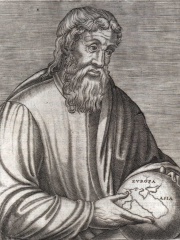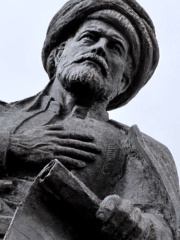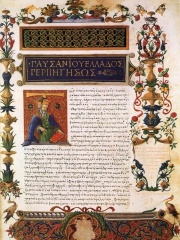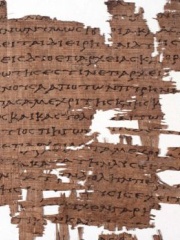



The Most Famous
GEOGRAPHERS from Türkiye
This page contains a list of the greatest Turkish Geographers. The pantheon dataset contains 86 Geographers, 4 of which were born in Türkiye. This makes Türkiye the birth place of the 6th most number of Geographers behind United States, and Spain.
Top 4
The following people are considered by Pantheon to be the most legendary Turkish Geographers of all time. This list of famous Turkish Geographers is sorted by HPI (Historical Popularity Index), a metric that aggregates information on a biography's online popularity.

1. Strabo (64 BC - 23)
With an HPI of 84.37, Strabo is the most famous Turkish Geographer. His biography has been translated into 93 different languages on wikipedia.
Strabo (; Greek: Στράβων, romanized: Strábōn; 64 or 63 BC – c. 24 AD) was an ancient Greek geographer who lived in Asia Minor during the transitional period of the Roman Republic into the Roman Empire. He is best known for his work Geographica, which presented a descriptive history of people and places from different regions of the world known during his lifetime. Additionally, Strabo authored historical works, but only fragments and quotations of these survive in the writings of other authors.

2. Piri Reis (1470 - 1554)
With an HPI of 76.77, Piri Reis is the 2nd most famous Turkish Geographer. His biography has been translated into 58 different languages.
Piri Reis (Turkish: Pîrî Reis; born Muhiddin Piri; c. 1470–1553) was an Ottoman Turkish cartographer, admiral, navigator, and corsair. He is best known for his 1513 world map and his nautical atlas, the Kitab-ı Bahriye (Book of the Sea). His maps combined classical sources, his own seafaring knowledge, and information from new European discoveries. His cartography was more engaged with the Age of Discovery than other Ottoman works from the period. He began his maritime career sailing with his uncle, the corsair Kemal Reis, with whom he entered Ottoman naval service. He later commanded his own ship in the Ottoman–Venetian wars and, following his uncle’s death, began the cartographic work for which he became best known. Returning to the fleet by 1516, he took part in the Ottoman conquest of Egypt. He presented his world maps and atlases as gifts to the Ottoman Sultan, and commanded a small group of ships in naval operations in the eastern Mediterranean. Later, as grand admiral of the Ottoman fleet in the Indian Ocean, Piri Reis led successful campaigns in the Red Sea, but was executed following his retreat from the siege of Hormuz Island at the mouth of the Persian Gulf. During his lifetime, Piri Reis' cartography received little appreciation, but many copies of the Kitab-ı Bahriye were produced after his death. The 1929 rediscovery of his first world map, during renovations to the Topkapı Palace in Istanbul, increased interest in his work in part because it cites many contemporary Portuguese explorers and a now-lost map by Christopher Columbus. The rediscovery made his career a point of national pride for Turkey. Although the map has been the subject of fringe theories based on the disproven hypothesis that the map depicted an ice-free Antarctica, studies have shown no significant similarities between the map and Antarctica's subglacial coast. Nevertheless, this speculation has increased interest in Piri Reis' cartography.

3. Pausanias (110 - 180)
With an HPI of 76.58, Pausanias is the 3rd most famous Turkish Geographer. His biography has been translated into 53 different languages.
Pausanias ( paw-SAY-nee-əs; Ancient Greek: Παυσανίας; c. 110 – c. 180) was a Greek traveler and geographer. He is famous for his Description of Greece (Ἑλλάδος Περιήγησις, Hēlládos Periḗgēsis), a lengthy work that describes ancient Greece from his firsthand observations. Description of Greece provides crucial information for making links between classical literature and modern archaeology, which is providing evidence of the sites and cultural details he mentions although knowledge of their existence may have become lost or relegated to myth or legend.

4. Artemidorus Ephesius (150 BC - 100 BC)
With an HPI of 63.57, Artemidorus Ephesius is the 4th most famous Turkish Geographer. His biography has been translated into 19 different languages.
Artemidorus of Ephesus (Ancient Greek: Ἀρτεμίδωρος ὁ Ἐφέσιος; Latin: Artemidorus Ephesius) was a Greek geographer, who flourished around 100 BC. His work in eleven books is often quoted by Strabo. What is thought to be a possible fragment of his work is considered by some scholars to be a forgery.
People
Pantheon has 4 people classified as Turkish geographers born between 150 BC and 1470. Of these 4, none of them are still alive today. The most famous deceased Turkish geographers include Strabo, Piri Reis, and Pausanias.
Deceased Turkish Geographers
Go to all RankingsStrabo
64 BC - 23
HPI: 84.37
Piri Reis
1470 - 1554
HPI: 76.77
Pausanias
110 - 180
HPI: 76.58
Artemidorus Ephesius
150 BC - 100 BC
HPI: 63.57

